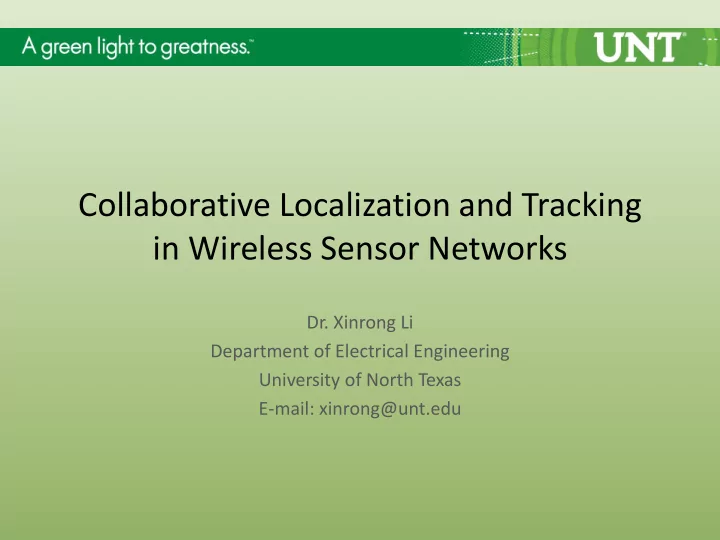

Collaborative Localization and Tracking in Wireless Sensor Networks Dr. Xinrong Li Department of Electrical Engineering University of North Texas E-mail: xinrong@unt.edu
Fundamental Limits of Localization with RF Signals • Location sensing modality: – TOA, TDOA, RSS, AOA, proximity, fingerprinting, … • Sources of uncertainties in location sensing: – Multipath, no-line-of-sight (NLOS)/blockage, interference, noise, system/hardware incapability, … • Localization-denied environments: – Indoor/in-building, and other multipath environments. – Also depends on application-specific accuracy requirement
Collaboration in Sensor Network • Individual sensor nodes have limited sensing, computing, and communication capacities. • Collaboration is the key – – To achieving substantial sensing and processing capabilities in the aggregate, and – To providing collectively reliable network behavior in mission critical applications. • With collaboration, distributed sensor nodes are aggregated to form a single collaborative system rather than greedy adversarial participants .
Collaboration in Sensing and Processing • Collaboration of distributed nodes in sensing is to – Provide large-scale sensing coverage, and to – Achieve superior sensing capabilities. – This is achieved by exploiting various diversity gains, multiple sensing modalities, redundancy in high- density networks, and many other advantageous system and environmental conditions. • Collaboration in processing is to – Share the processing load among nodes to minimize energy consumption at each node, and/or to – Achieve substantially higher processing capacity in the aggregate than any node can offer individually.
Collaborative Localization • Non-Collaborative – Each sensor node is located based on measurements between the node and reference nodes • Collaborative – Measurements among sensor nodes are exploited – Every sensor node can act as pseudo-reference node to other sensor nodes – This may provide opportunities to improve geometric conditioning and to mitigate adverse multipath and NLOS effects
Collaborative Multi-Sensor Tracking (CMST) • Tracking – To exploit mobility of sensor nodes • Collaborative multi-sensor tracking – To combine the power of collaboration and tracking.
An Example
RMSE CRB Comparison
Particle Filters to Implement CMST
Selected Publications • Xinrong Li, "Collaborative multi-sensor tracking in mobile wireless sensor networks," International Journal of Sensor Networks (IJSNET), InderScience Journals, Vol. 8, No. 3/4, 2010. • Xinrong Li, "Distributed implementation of particle filters for collaborative tracking in mobile ad-hoc and sensor networks," International Conference on Signal Processing (ICSP), Beijing, China, October 2008. • Xinrong Li, "Collaborative localization with received signal strength in wireless sensor networks," IEEE Transactions on Vehicular Technology , vol. 56, no. 6, pp. 3807-3817, November 2007. • Xinrong Li and Jue Yang, "Sequential Monte Carlo methods for collaborative multi-sensor tracking," IEEE Military Communications Conference (MILCOM), Orlando, FL, October 2007.
Recommend
More recommend